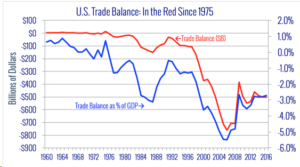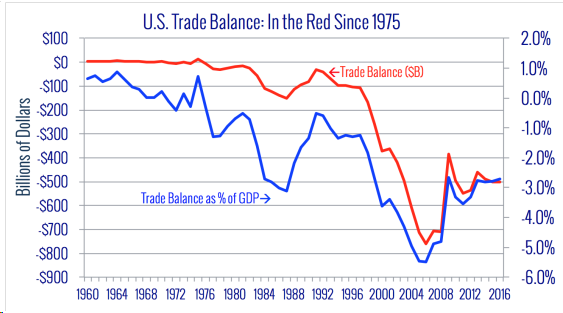Free trade has resulted in enormous trade deficits in goods for the United States for over 40 years. Our last year of a positive trade balance was 1975. At best, free trade has benefited large, multinational global corporations that have manufacturing facilities located in other countries. At its worst, it is the primary source of our trade deficit and loss of good paying manufacturing jobs.
Even with the tremendous resources we have, what was once the world’s largest manufacturer of products has accumulated $14.379 trillion worth of deficits in goods for all countries since 1991.
A fact sheet generated by the Coalition for a Prosperous America for 2018 show ten countries account for 97% of our trade deficit: China, Mexico, Japan, Germany, Ireland, Vietnam, Italy, India, South Korea, and Malaysia. Our trade deficit with China alone was $419 billion, representing 47.9% of our trade deficit. Since 1991, we have accumulated over $9.144 trillion worth of trade deficits with just the top four countries. If we had fair trade, we would not have these constant trade deficits. The drastic effect China has had on our trade deficit is demonstrated by the fact that in 2001 when China joined the World Trade Organization, we had a total $412 billion deficit in goods, but in 2018, we had a $879 billion deficit in goods.
For every $1 billion of trade deficits in goods, it’s been estimated that 6,000 – 7,000 jobs are lost, at about $80,000/job. This means that 8 – 10 million more Americans willing to work could have a comfortable middle-class job in America. Instead, we lost 5.8 million manufacturing jobs from the year 2000 to 2010.
In terms of purchasing power, workers’ wages in the U.S. have been stagnant since the 1970s. The significant collapse in the income of average Americans can be attributed to the vast decline of jobs in the U.S. manufacturing sector. This is the reason average U.S. wages have fallen over time, especially since 2001. From 2001 – 2013, the average U.S. wages fell by 3.5%. In contrast, as Chinese workers flocked to cities for manufacturing jobs, wages have grown substantially, averaging an 11 percent increase per year from 2001 to 2015.
According to the Pew Research Center, 61% of American households were part of the middle class in 1971, but by 2015, only 50% of Americans were part of the middle class. “In 2002, China’s middle class was only four percent of its population. A decade later, this number had climbed to 31 percent, constituting over 420 million people. In contrast, in 1999, only 2% of the Chinese population was a part of the middle class, but by 2013, 39% of the Chinese population was in the middle class.
Since China joined the World Trade Organization, the bi-partisan, 12 member U. S.-China Economic and Security Review Commission (USCC) has been required to submit annual reports to Congress. These reports document China’s non-compliance with the WTO and the effect it has on the U. S. economy.
For example, the 2007 report included a case study of the local impact of trade with China on North Carolina. The USCC report stated “the accelerating decline in North Carolina’s manufacturing employment is due in large measure to increasing competition from imports mostly from China . . . The combination of China’s 2001 admission to the World Trade Organization (WTO), which gave it quota-free access to U.S. markets for its textile and clothing exports, and the subsequent U.S. grant of Most-Favored (Trading) Nation status that lowered most tariffs on Chinese imports, battered North Carolina’s textile and apparel industries, and they never recovered.”
Because a greater proportion of North Carolina’s workforce had manufacturing jobs than any other state, North Carolina’s workforce was more vulnerable to competition from imports than the workforces of other states. North Carolina’s manufacturing economy was made even more vulnerable by its concentration in the import-sensitive sectors of textiles, apparel, and furniture. North Carolina is one of the southeast states that had a large number of textile companies, and as a result, North Carolina has been the most impacted state in the nation by layoffs due to trade. Between 2004 and 2006, almost 39,000 North Carolina workers were certified by the Trade Adjustment Assistance program as having lost jobs to trade, more than 10 percent of the U.S. total of 387,755.
According to the Social Science Research Institute (SSRI) of Duke University in North Carolina, there were 2,153 textile and apparel plants in North Carolina employing 233,715 people in 1996. By 2006, the apparel industry had experienced a 70% decline in jobs and 55% loss of plants. The textile industry by comparison had only lost 63% of jobs and 32% of plants from 1996 to 2006.
The loss of these well-paid manufacturing jobs in North Carolina’s textile industry may have resulted in families losing their homes and/or being forced to relocate to other areas of the country to find jobs. Taking lower paying jobs in their own communities may have resulted in families no longer being in the middle-class income range. And, those who have not been able to find any work or only part-time work may have even dropped down to the poverty level. It is not just people losing jobs and not being able to find other employment that pays as well as their former jobs, “hundreds of small towns throughout North Carolina impacted by plant closures are dying.”
Remember that it takes taxes paid by three to four working Americans to pay for the unemployment benefits of a non-working American. The cheaper China price of goods that we import instead of producing here in the U. S. results in a cost to society as a whole. We need to ask ourselves: Is the China price worth the cost to society? I say a resounding NO! We need to stop shooting ourselves in the feet. We need to stop benefitting the one percent of large multinational corporations to the detriment of the 99% percent of smaller American companies.
China, Germany, Japan, and many other countries have built their currency value around making certain all of their countrymen have a good job, even if that destroys America’s work force. As a result, these countries have maintained constant trade surpluses with the U. S. for many years, which would not have happened if we had fair trade.
It is impossible for the U.S.to remain competitive if our currency is not fairly valued. In order to move manufacturing jobs back to the U.S., we need to move our currency value down by at least 27% because the currency of Germany and Japan are undervalued by about that same amount. China has rigged its currency between 15%-40% below its fair value since joining the WTO, and this gives a subsidy to their imports to the U.S. and imposes a direct cost on U.S. exports to China.
Devaluing our currency would allow many more products that we import from overseas to be made here. Unfair trade practices of currency manipulation, government subsidies, product dumping, and state-owned enterprises have allowed China to buy our raw materials and our low-cost energy to become the largest producer in the world of paper, aluminum, and steel even though labor costs are small compared to the cost of raw materials, energy, and transportation.
We need to focus on eliminating our trade deficits and achieving balanced, reciprocal trade in all future trade agreements. The last thing we need is to increase our trade deficit more than it already is.
In addition, we need to continue on the path of returning more manufacturing to America by reforming our tax policies and making regulations less onerous to manufacturers, without compromising our commitment to protect our environment. This is the only way that we will be able to simultaneously reduce our trade deficit and the national debt.
 Source: Coalition for a Prosperous America
Source: Coalition for a Prosperous America